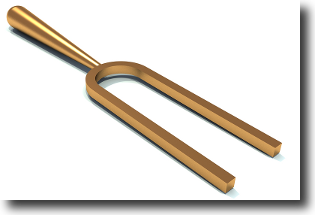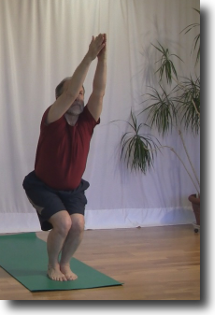The tuning fork hit the edge of the counter hard. Bob watched as the arms vibrated rapidly back and forth. He could hear the perfect “C” note that it created. “I’ll take it.” Said Bob to the salesman. Bob was looking for a gift for his nephew’s birthday. The tuning fork was perfect.
Bob’s yoga teacher has been talking to Bob about tuning forks a lot lately. You see, Bob has tuning fork arms. Bob’s teacher says that his tuning fork arms have to go.
There are couple of poses that Bob has tuning fork arms in including Utkatasana.
What is Utkatasana
Utkatasana is one of the standing poses that appears towards the end of the standing series of poses in Ashtanga Yoga. It is also the first and last pose in the Sun Salute B series.
Utkatasana is the Sanskrit name of the pose and it translates as “Fierce pose”. This pose has many other English names including chair pose, zig zag pose and lightening bolt pose. From the side you look like a thunder bolt or that you are about to sit down in a chair.
It is called Fierce Pose because it requires a lot of quadriceps strength and abdominal strength to hold this pose for an extended period of time.
Even though the pose has many names they all have the same benefits. You strengthen your ankles, calves, and spine. While you are strengthening your legs you are also stretching your shoulder and chest muscles while you stimulate your abdominal organs, diaphragm and heart.
Utkatasana is a fairly easy pose to get into. There is no binding, twisting or lifting involved.
How to do Utkatasana
You start in Tadasana, standing tall at the top of your mat with your arms by your side and your big toes touching. There is a slight gap between your heels.
To enter the pose you exhale, bend your knees forward and lower your hips towards the floor. At the same time you lean forward slightly and raise your arms up over your head.
Your palms should be touching and your wrists, shoulders and hips should be in a straight line.
Bring your gaze towards your hands by lifting your chin slightly and looking through your eyebrows.
You are now in the pose. Hold here for several breaths.
Even though it is an easy pose to get into Bob is having a problem with his arms. He has tuning fork arms.
Why Does Bob have tuning fork arms
When Bob brings his arms up over his head he can not get his palms to come together. The best he can do is get his arms almost parallel to each other. There is a fairly large gap between his hands when he holds his arms straight. He looks like a tuning fork.
This is a sign that Bob needs to develop some additional flexibility.
Why is there a problem with Bob’s arms
Bob lacks enough range of motion in his shoulders to get his hand to come together above is head.
At this point Bob is tempted to do a couple of things to get his hands together and these are mistakes.
Mistake #1 – Bend your arms to get your hands to touch
This is a very common mistake that most people do when they follow the teacher’s instructions to bring their hands together. However when you bend your elbows and bring your hands together you are no longer working on increasing the flexibility in your shoulders.
Mistake #2 – Interlace your fingers to get your hands to stay together
This happens when your hands are almost touching. If you clasp your hands by interlacing your fingers you will be able to firmly bring your palms together.
This is not a good thing either. When you clasp your hands you are using a different set of muscles in your arms and you stop working on increasing the flexibility in your shoulders.
Mistake #3 – Lift your shoulders up towards your ears
Finally Bob attempts to get his palms to come together by raising his shoulders up towards his ears. This will sometimes help to get his palms closer together, but it causes stress and tension in the muscles of his shoulders, neck and upper back.
Rather than developing flexibility in his shoulders these mistakes avoid the problem area or make the problem worse. There is something that Bob can do however to get his hands to come together.
How to eliminate the tuning fork arms
First of all Bob needs to make sure that he keeps his shoulder blades down his back and away from his ears. This insures that he will not develop stress in the muscles of his upper back and neck.
Next Bob needs to work with his Edge. The Edge is that place beyond comfort and short of discomfort. The Edge is the challenging yet comfortable position.
In this case Bob is focused on his shoulder muscles and the Edge in this area. As he brings his arms towards each other his shoulders are going to start to complain at some point that they can go no further. Bob needs to stop just short of that point where the complaint becomes painful.
Staying at the Edge, that comfortable but challenging spot, will allow Bob’s muscles to relax and lengthen slightly and over time his range of motion will increase and his palms will start to touch.
Summary
Over time Bob’s tuning fork arms will go away as he works with his Edge and he will be able to hold his palms together in Utkatasana with ease. Then the only tuning fork in Bob’s life will be the one that he bought at the music store for his nephew.
Next Step
Ask your teacher to help you with your tuning fork arms. They can make sure that you avoid the mistakes while you work on your shoulder flexibility.





